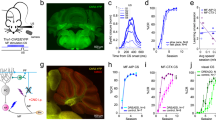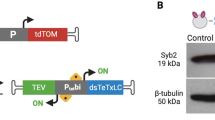Abstract
PERSISTENT neuronal plasticity, including that observed at some hippocampal synapses, requires N-methyl-D-aspartate (NMDA)-mediated transmission. NMDA receptor activation may be necessary for hippocampus-dependent learning as antagonists block acquisition in many such tasks. The behavioural effects of NMDA agonists are less well defined. We have shown that a monoclonal antibody (B6B21) displaced [3H]-glycine that was bound specifically to the NMDA receptor, and enhanced the opening of its integral cation channel in a glycine-like fashion, effects that were competitively antagonized by 7-chlorokynurenic acid1. B6B21 also enhanced long-term potentiation in hippocampal slices1. We report here that intraventricular infusions of B6B21 significantly enhances acquisition rates in hippocampus-dependent trace eye blink conditioning in rabbits, halving the number of trials required to reach a criterion of 80% conditioned responses. Peripheral injections of D-cycloserine, a partial agonist of the glycine site on the NMDA receptor which crosses the blood–brain barrier, also doubles rabbits' learning rates. Pseudoconditioning control experiments indicated a lack of nonspecific behavioural sensitization effects. Our data suggest that enhanced activation of the glycine coagonist site on the NMDA receptor/channel complex facilitates one form of associative learning and may be used in other learning tasks.
This is a preview of subscription content, access via your institution
Access options
Subscribe to this journal
Receive 51 print issues and online access
$199.00 per year
only $3.90 per issue
Buy this article
- Purchase on Springer Link
- Instant access to full article PDF
Prices may be subject to local taxes which are calculated during checkout
Similar content being viewed by others
References
Haring, R., Stanton, P., Scheideler, M. & Moskal, J. J. Neurochem. 57, 323–332 (1991).
Patel, J., Zinkland, W. C., Thompson, C., Keith, R. & Salama, A. J. Neurochem. 54, 849–854 (1990).
Moyer, J. R. Jr, Deyo, R. A. & Disterhoft, J. F. Behavl Neurosci. 104, 243–252 (1990).
Monaghan, D. T. & Cotman, C. W. J. Neurosci. 5, 2909–2919 (1985).
Collingridge, G. L., Kehl, S. J. & McLennan, H. J. Physiol, Lond. 334, 33–46 (1983).
Oliver, M. W., Kessler, M., Larson, J., Schottler, F. & Lynch, G. Synapse 5, 265–270 (1990).
Thomson, A. M., Walker, V. E. & Flynn, D. M. Nature 338, 422–424 (1989).
Andersen, P. & Hvalby, Ø. in Excitatory Amino Acids (eds Meldrum, B. S., Moroni, F., Simon, R. P. & Woods, J. H.) 463–4 4 (Raven, New York, 1991).
Morris, R. G. M., Anderson, E., Lynch, G. S. & Baudry, M. Nature 319, 774–776 (1986).
Robinson, G. S., Crooks, G. B., Shinkman, P. G. & Gallagher, M. Psychobiology 17, 156–164 (1989).
Contreras, P. C. Neuropharmacology 29, 291–293 (1990).
Napier, R., MacRae, M. & Kehoe, E. J. exp. Psychol, Anim. Behav. Processes 18, 182–192 (1992).
Hood, W. F., Compton, R. P. & Monahan, J. B. Neurosci. Lett. 98, 91–95 (1989).
Hanngren, H., Hansson, E. & Ullberg, S. Antibiotics Chemother. 12, 46–54 (1961).
Monahan, J. B., Corpus, V. M., Hood, W. F., Thomas, J. W. & Compton, R. P. J. Neurochem 53, 370–375 (1989).
Watson, G. B., Bolanowski, M. A., Baganoff, M. P., Deppeler, C. L. & Lanthorn, T. H. Brain Res. 510, 158–160 (1990).
Golub, E. S. Immunology: A Synthesis (Sinauer, Sunderland, MA, 1987).
Vartanian, M. G. & Taylor, C. P. Neurosci. Lett. 133, 109–112 (1991).
Monahan, J. B., Handelmann, G. E., Hood, W. F. & Cordi, A. A. Pharmac. biochem. Behav. 34, 649–653 (1989).
Schwartz, B. L., Hashtroudi, S., Herting, R. L., Handerson, H. & Deutsch, S. I. Neurology 41, 1341–1343 (1991).
Thiels, E., Weisz, D. J. & Berger, T. W. Neuroscience 46, 501–509 (1992).
Disterhoft, J. F., Coulter, D. A. & Alkon, D. L. Proc. natn. Acad. Sci. U.S.A. 83, 2733–2737 (1986).
de Jonge, M. C., Black, J., Deyo, R. A. & Disterhoft, J. F. Expl Brain Res. 80, 456–462 (1990).
Solomon, P. R., van der Schaaf, E. V., Thompson, R. F. & Weisz, D. J. Behavl Neurosci. 100, 729–744 (1986).
Gaffan, D. & Gaffan, E. A. Brain 114, 2611–2618 (1991).
Squire, L. Memory and Brain (Oxford, Univ. Press, London, 1987).
Dedrick, R. L. & Flessner, M. F. in Immunity to Cancer II (ed. Mitchell, M. S.) 429–438 (Liss, New York, 1989).
Winter, G. & Milstein, C. Nature 349, 293–299 (1991).
Saragovi, H. U. et al. Science 253, 792–795 (1991).
Woodruff-Pak, D. S. & Thompson, R. F. Psychol. Aging 3, 219–229 (1988).
Solomon, P. R., Levine, E., Bein, T. & Pendlebury, W. W. Neurobiol. Aging 12, 283–287 (1991).
Miyoshi, R., Kito, S., Doudou, N. & Nomoto, T. Synapse 6, 338–343 (1990).
Foster, A. C., Willis, C. L. & Tridgett, R. Eur. J. Neurosci. 2, 270–277 (1990).
Procter, A. W., Stirling, J. M., Stratmann, G. C., Cross, A. J. & Bowen, D. M. Neurosci. Lett. 101, 62–66 (1989).
Moskal, J. R. & Schaffner, A. E. J. Neurosci. 6, 2045–2063 (1986).
Deyo, R. A., Straube, K. & Disterhoft, J. F. Science 243, 809–811 (1989).
Berger, T. W., Rinaldi, P. C., Weisz, D. J. & Thomspon, R. F. J. Neurophysiol. 50, 1197–1219 (1983).
Author information
Authors and Affiliations
Rights and permissions
About this article
Cite this article
Thompson, L., Moskal, J. & Disterhoft, J. Hippocampus-dependent learning facilitated by a monoclonal antibody or D-cycloserine. Nature 359, 638–641 (1992). https://doi.org/10.1038/359638a0
Received:
Accepted:
Issue Date:
DOI: https://doi.org/10.1038/359638a0
This article is cited by
-
High-fat diet impairs spatial memory and hippocampal intrinsic excitability and sex-dependently alters circulating insulin and hippocampal insulin sensitivity
Biology of Sex Differences (2016)
-
D-Cycloserine 24 and 48 Hours after Asphyxial Cardiac Arrest has No Effect on Hippocampal CA1 Neuropathology
Journal of Cerebral Blood Flow & Metabolism (2014)
-
GLYX-13, a NMDA Receptor Glycine-Site Functional Partial Agonist, Induces Antidepressant-Like Effects Without Ketamine-Like Side Effects
Neuropsychopharmacology (2013)
-
Previous Stress Attenuates the Susceptibility to Midazolam's Disruptive Effect on Fear Memory Reconsolidation: Influence of Pre-Reactivation D-Cycloserine Administration
Neuropsychopharmacology (2010)
-
The molecular and cellular biology of enhanced cognition
Nature Reviews Neuroscience (2009)
Comments
By submitting a comment you agree to abide by our Terms and Community Guidelines. If you find something abusive or that does not comply with our terms or guidelines please flag it as inappropriate.



